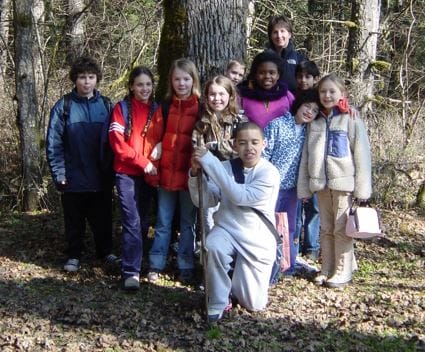Learning From Students

Twenty-five architecture students stood in a semicircle around the tree. They had chosen this tree because, of all the trees in the tightly spaced grove of thirty year old firs, it was the smallest and least vigorous. Losing the competition for sun and other sustaining resources, we all knew that the tree’s decline would continue and lead to ecologically inevitable death in the coming years. The students’ eyes on the tree reminded me of a jury that had just delivered a death sentence. They’d join me in the forester’s task of carefully deciding which tree should be thinned. Scanning their diverse, youthful faces, I wondered what thoughts and feelings they might be experiencing – remorse, responsibility, guilt, excitement...? It occurred to me that, by chance, their ages and the tree’s were roughly the same. How different would the scene be if they were chefs in training who had decided which of the pigs would be sacrificed for next week’s supper?
The group’s silence was broken by the posing of a question: “If we respect this tree and feel gratitude for its life in tree form, what might be the best ways to communicate those feelings?”. Following a reflective pause, suggestions were shared. “We could express our feelings to the tree in words; we could tell it.”. “We could lay our hands on it - or hug it...”. One student shared suggestions born from her life experience as a member of the nearby Siletz Nation, including learning about and applying the principles central to the broadly embraced concept of the honorable harvest. The supportive group appeared to welcome all suggestions, but with the clock ticking toward the hour when their vehicles needed to speed them back to the city in time for the next class, no conclusions were reached. Between putting on my logger’s protective equipment and reaching for my chainsaw, I attempted to put into action some of the students’ suggestions; reaching out I placed my palm on the tree’s crenulated bark, surveyed it from base to crown and voiced well-intentioned, but awkward-feeling, words of gratitude to the tree and my student companions.
Firing up the saw, I quickly moved through the sequential steps of felling the tree. With the final cut, the cut’s back hinge slowly opened, the green crown moved through the canopy and the tree fell to the forest floor’s soft duff with a whoosh followed by a thud – followed by silence. With twenty-five pair of eyes on me, I moved along the now horizontal trunk cutting off the limbs and bucking it into millable logs. As the students and their professors organized themselves to drag the largest log to our nearby sawmill, I stopped to acknowledge my unsettled feeling that something didn’t sit right. Yes, using words to communicate gratitude and respect was a good step, but was it enough? Couldn’t we do better? With the mill warmed up and the log secured on the mill’s bed, I shut down the loud engine, flipped up my ear protectors and turned to the anxiously watching group with a simple question and a more complex one. “If this log’s lumber will become part of the table that you’ll be designing and building, what dimensions would you like me to mill it to?” and “Reflecting on gratitude and respect, could it be that the best way for us to communicate our feelings is through the act of making something really beautiful, useful, long-lived and good from the gift of its lumber?”. Had the pressure of time allowed for it, I’m certain that we’d have all learned from a discussion of this question, but time did not allow and we ended their too brief visit with the question left unexplored – but hopefully in place in their heads and hearts?
Of course, no one missed that my question was a rhetorical one. While, yes, we should and do voice our feelings and I seldom pass up the chance to hug a tree, I believe that the most powerful ways that we communicate gratitude and respect for the tree’s life and gift is through the ways that we transform it into its second life. And this is what the students did, as shown in the photos below. Speaking of gifts, their visit and our discussions gave me the gift of learning from them. The lessons learned continue to productively circulate in my head and in my heart as we continue our dance with the forest.
Possibly Spooky Postscript - During the work of falling and milling the tree, it felt like the two saws were trying to tell us something. The normally smooth running chainsaw sputtered and died three times as I worked to fall and process the tree. No sooner was the sawmill warmed up and ready with all student eyes and camera phones focus on the log than the mill suddenly died and refused to restart. Following a week of repair work, I milled the log and delivered the lumber to the university. Coincidences or......?